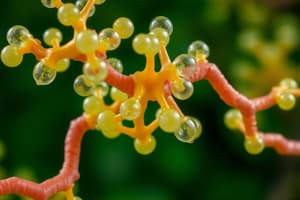Podcast
Questions and Answers
What is the result of hydrolysis of Anthraquinone glycosides?
What is the result of hydrolysis of Anthraquinone glycosides?
- Yielding chrysarobin and water
- Yielding xylose and calcium
- Yielding alizarin and glucose (correct)
- Yielding barbaloin and anthrone
What is the use of Alizarin in clinical practice?
What is the use of Alizarin in clinical practice?
- To assess bone growth
- To treat arthritis
- To diagnose Pseudogout (correct)
- To treat osteoporosis
What is the characteristic of anthraquinone glycosides in terms of their color?
What is the characteristic of anthraquinone glycosides in terms of their color?
- Yellow-green
- Orange-red (correct)
- Colorless
- Blue-violet
What is the primary mechanism of action of laxative glycosides in the gut?
What is the primary mechanism of action of laxative glycosides in the gut?
What is the effect of oxidation with fuming HNO3 on Chrysarobin?
What is the effect of oxidation with fuming HNO3 on Chrysarobin?
What is the characteristic of Chrysarobin in borax solution?
What is the characteristic of Chrysarobin in borax solution?
Which type of glycosides is easily hydrolyzed?
Which type of glycosides is easily hydrolyzed?
What type of glycosides are barbaloin, β-barbaloin, and isobarbaloin?
What type of glycosides are barbaloin, β-barbaloin, and isobarbaloin?
What is the reduced form of anthraquinone occurring in plants?
What is the reduced form of anthraquinone occurring in plants?
What type of glycosides has a weak reducing property?
What type of glycosides has a weak reducing property?
What is the medical term for Pseudogout?
What is the medical term for Pseudogout?
Which type of glycoside is difficult to hydrolyze?
Which type of glycoside is difficult to hydrolyze?
What is the purpose of adding H2O2 in the evaluation of anthraquinones?
What is the purpose of adding H2O2 in the evaluation of anthraquinones?
What is the outcome of adding NH4OH to the filtrate in Borntrager's test?
What is the outcome of adding NH4OH to the filtrate in Borntrager's test?
What is the purpose of using an immiscible organic solvent in Borntrager's test?
What is the purpose of using an immiscible organic solvent in Borntrager's test?
Which of the following is NOT a method for evaluating anthraquinones?
Which of the following is NOT a method for evaluating anthraquinones?
What is the structure of Alizarin glycoside?
What is the structure of Alizarin glycoside?
Which of the following plant species is known to contain Alizarin glycoside?
Which of the following plant species is known to contain Alizarin glycoside?
Study Notes
Anthraquinones
- Alizarin glycoside: 1-hydroxy anthraquinone-2-O-glucoxyloside, found in Rubia species (R.tinctorum and R.cordifolia)
- Hydrolysis: yields alizarin, glucose, and xylose sugars by acid hydrolysis
- Uses:
- Moderate laxative
- Natural dye for red dying of textile fabric
- Stains tissue containing calcium red immediately (used in clinical practice to stain synovial fluid to assess for basic calcium phosphate crystals in Pseudogout)
- Pseudogout: a form of arthritis resulting from deposits of calcium pyrophosphate crystals, commonly affecting knees and wrists
Anthranols and Anthrones
- Chrysarobin: 1,8-dihydroxy-3-methylanthranol, found in Andira araroba (Leguminosae)
- Properties:
- Yields chrysophanol by oxidation with fuming HNO3
- Gives strong green fluorescence in borax and other alkaline solutions, becoming more distinct upon dilution with water (Schonteten's test)
C-Glycosides (Aloin)
- A mixture of C-glycosides obtained from different species of Aloes
- Includes barbaloin, β-barbaloin, and isobarbaloin (anthrone-C-glycosides)
Anthracene Glycosides
- Classification:
- Anthraquinone derivatives
- Anthrones and anthronols
- Dianthrone and dianthranol
- Oxanthrone
- Laxative glycosides:
- 3 oxygenated or substituted forms of anthracene molecule exist
- Anthraquinone (most common), anthrone (reduced form), and dianthrone (reduced dimer)
- Phenolic moiety is the irritant principle
- Characters:
- Anthraquinone derivatives are often orange-red compounds with weak reducing properties
- Present in plants either in free form (aglycones) or combined form (glycosides)
- Tests for Identity:
- Borntrager's test: in alkali, phenolic groups form phenate complex (bright red)
- Free anthraquinones: powdered drug is extracted with an immiscible organic solvent, filtered, and treated with NH4OH (or NaOH or KOH) to produce a red color
- Evaluation or Estimation:
- Methods used: gravimetric and colourimetric
- Aglycones are isolated according to Borntrager's reaction, and the intensity of the alkaline solution is measured in a colorimeter using 1,8-dihydroxyanthraquinone as a standard
Studying That Suits You
Use AI to generate personalized quizzes and flashcards to suit your learning preferences.
Description
This quiz covers the classification of anthracene glycosides, a group of glycosides with anthracene derivatives as aglycones. Learn about the different types, including anthraquinone derivatives, anthrones and anthronols, dianthrone and dianthranol, and oxanthrone.




